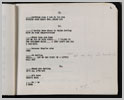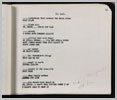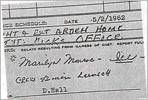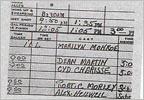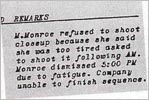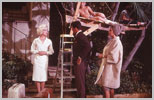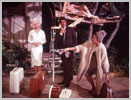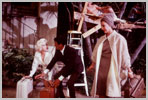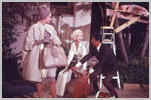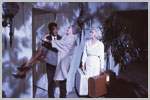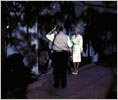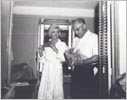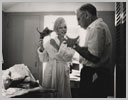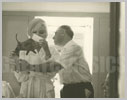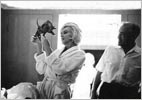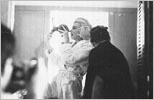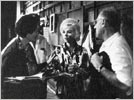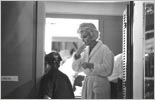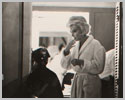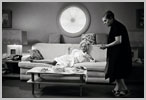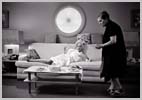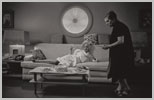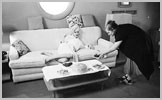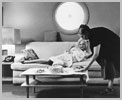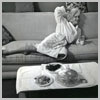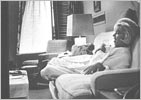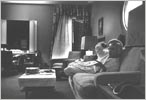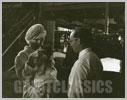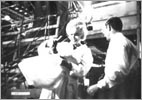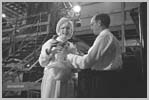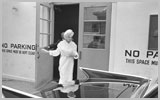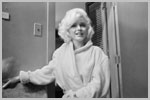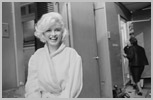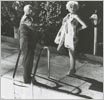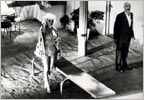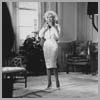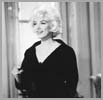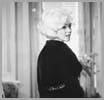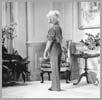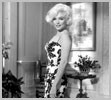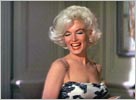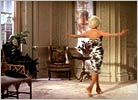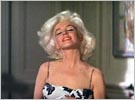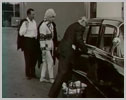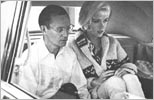
My journey ends here...
Something's Got to Give (1962)
"Something's Got to Give" would have been Marilyn's 30th movie.
Only a third was shot before it had been given up, but it didn't prevent many biographers from writing more about this unfinished movie than about the 29th movies Marilyn had shot.This movie was suggested to Marilyn; according to the contract she had signed in 1956, she still owed 2 movies to the Fox. It has often been said that Marilyn's first reaction was to refuse this movie, but her psychoanalysis Dr Ralph Greenson, among others, convinced her to agree : he thought that going back to work could only be salutary after the emotional upsets she had suffered from in 1961. One of the reasons for which she was suggested, was that the production company of her friend Dean Martin, took part in the project.
From a drama point of view, the part differd from the characters she had played since then. She embodied a mother and a wife, and in the sequences which have survived , she says her text in a natural voice, and not with the panting intonations to which her fans were used to.
About her career, it was an important project. Marilyn's two former movies, "Let's Make Love" (1960) and "The Misfits" (1961), hadn't had the success she was used to, and she desperatly wanted to silence the critics who claimed she was over.
Once again, she earned clearly less than the other
actors, 100 000$, plus 500$ a week of shooting, while it's said
that her partner Dean
Martin and the director George Cukor were paid 300
000$ each.
Cukor was under a long-term contract with the studio and also owed a movie; it was the original producer, David Brown, who appealed to him. According biographer Fred Lawrence
Guiles, not less than 7 screenwriters contributed to what everyone considered as a fully boring screenplay. It was for Nunnally Johnson's one,
with who she had already worked on "How to Marry a Millionaire?" (1953), that Marilyn was the most enthusiastic.
However, Johnson left the project in March 1962, a month before the beginning of the shooting.
He was then replaced by Walter Bernstein, who was the only one to be paid for the screenplay, and received more than 300 000$.
During the shooting, the original screenplay was still rewritten; some Marilyn's suggestions were inserted, and every pages, except 4, were modified in a way or in another. At a moment, the studio tried to make believe to Marilyn that thescreenplay hadn't changed - she regretted that the changings spoiled the version she prefered - by giving her the rewritten pages on white paper, than on the usual revision blue pages.
The date of the beginning of the shooting was postponed from February to April 23, 1962, for the main part because of the screenplay issue. At that time, Peter Levathes, vice president in charge of the studio exploitation, had replaced the original producer, David Brown, by Henry Weinstein, a friend of Ralph Greenson, who seemed to have persuade Levathes that Marilyn would work better with someone who understood her. Greenson personally came on the set as Marilyn's private consultant.
April 23 arrived. Marilyn didn't come to work because she was sick, but Dean Martin was absent too, because he was still working on another movie. Marilyn went to the studio a week later, but she could shoot only one day : her fever started again and so her sinusitis.
Her private doctor, Dr Hyman Engelberg, and the studio doctor, Dr Lee Siegel, agreed on Marilyn's need of rest.
At home, Marilyn kept on working on the screenplay with Paula Strasberg, trying to face the huge changings and modifications she almost received daily. Meanwhile, Cukor chose, for want of anything better, to shoot the scenes of the other actors and the shots taken from Marilyn's point of view.
Marilyn came to work for a fews days in a row around mid-May, but on May 17, she left to New York. Immediately the studio warned her that this trip was a breach of contract, but it's also said that the heads of the studio had given her their tacit agreement.
On May 19, at the Madison Square Garden, Marilyn sang "Happy Birthday" to John Kennedy. Once back, she went back to work and notably shot the pool scene, where spontaneously she took her flesh-colored bathsuit off, and posed for the last nudes of her life.
However, it had always been decided to put an end to the production.
Ralph Greenson led the negotiations - he was called back in Los Angeles while he was on a trip in Europe.
Marilyn's dismissal circumstances have to be considered still thinking about the huge difficulties the Fox and the movie industry, as a whole, had at that time.
The Fox was left in a precarious financial situation because of the huge cost overrun of the Elizabeth Taylor's movie, "Cleopatra" (1963), which exceeded 30 millions $ (including a big million for Elizabeth Taylor). It has to be added the televison competition sustained by all the Hollywood studios, because many American households from then on, owned a TV set, and the stars growing power - a "transfer of power" that Marilyn herself had contributed to initiate, by leaving the studios in the middle of the 50's and in renegotiating a more favorable contract.
It can be considered that the Fox was looking for an excuse to put an end to the movie. Many biographers proposed that the studio wanted to get the money back by taking advantage of the insurance, and deliberately insisted on Marilyn's bad health and her lack of reliability to justify her dismissal. At the era of all those events, the Fox old guard was replaced by new directors, the owners of the studios throwing into a panic about the society loss of influence.
On June 7, 1962, Marilyn was officially dismissed for "breach of contract", after Levathes had stopped the project.
The studio sued Marilyn, claiming for 500 000$ damages, then brought up to 750 000$. Between the production suspension and Marilyn's official dismissal, the studio looked for a substitute. After Kim Novak and Shirley
MacLaine's refusal, the Fox
chose Lee Remick ( ). Finally, this choice didn't matter, because a
clause of Dean Martin's contract planned that he agreed on the
feminine leading role : he refused to work with anybody else than
Marilyn. In reprisal, the studio then sued Dean Martin's production
company for the total cost of the movie, ie more than 3 millions $.
). Finally, this choice didn't matter, because a
clause of Dean Martin's contract planned that he agreed on the
feminine leading role : he refused to work with anybody else than
Marilyn. In reprisal, the studio then sued Dean Martin's production
company for the total cost of the movie, ie more than 3 millions $.
Marilyn fought to be reinstated in the movie. As she wrote it in a telegram to Robert Kennedy and his wife, who had invited her to visit them in Virginia : "I would have been delighted to have accepted your invitation honoring Pat and Peter Lawford. Unfortunately I am involved in a freedom ride protesting the loss of the minority rights belonging to the few remaining earthbound stars. After all, all we demanded was our right to twinkle".
Several weeks after Marilyn's dismissal, Spyros Skouras, longstanding Fox president, resigned. However, secretly, screenwriter Hal Kanter had been called to review the screenplay, and it was planned to reinstate Marilyn.
Marilyn's lawyer, Milton Rudin, set about working on the contractual details of her return in the set. On Marilyn's suggestion, Jean Negulesco was asked to know if he would agree to direct the movie.
Finally, the studio modify the screenplay and appealed to new actors for the project.
The movie was released in 1963, under the title of "Move Over, Darling", with James Garner and the number one
box-office blonde, Doris Day ( ).
).
According to Marilyn's fans unanimous opinion who have viewed her performance, she turned out to be a mature actress with a brilliant acting, more radiant and stunning than ever. Marilyn's stand-in in this movie, Evelyn Moriarty, has claimed that there were enough shots to finish the movie, even if the story had to be modified and even if techniques like the flash-back had to be used.
This unfinished movie is considered as the ideal candidate for a compilation produced by a computer, once the technology would be able to reproduce the actors on the screen.
Production
White suit
with Dean Martin
Mink suit
 ,
,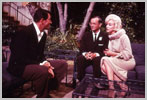 ,
, ,
, (more pics here).
(more pics here). Off set
with George Cukor
with Paula Strasberg
alone
Bathsuit
Bathrobe
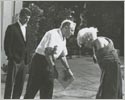 ,
,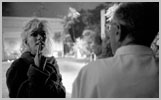 ,
, ,
, (more pics here).
(more pics here). Swimming-pool
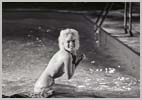 ,
, ,
, ,
,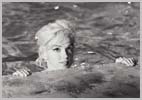 ,
, (more pics here).
(more pics here). Flowery dress
 ,
,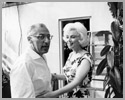 ,
, ,
, ,
, (more pics here).
(more pics here). Flowery dress and white coat
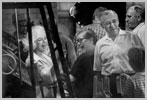 ,
, ,
,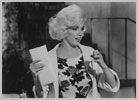 ,
, (more pics here).
(more pics here). Costumes tests
black suit
bathsuit
pants and blouse
thin straps dress
black lace dress
 -
- ,
, ;
; ,
,
 ;
; ,
, ,
, ,
, shoes
shoes 
Hairdressing
June 1st 1962, Marilyn celebrates her birthday :  ,
, ,
,
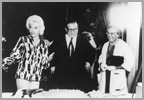 ,
, ,
,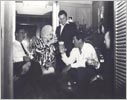 (more pics here).
(more pics here).
Marilyn leaving the Fox
CREDIT
Twentieth Century-Fox
Director : George Cukor
Producer : Henry Weinstein
Screenplay : Nunnally Johnson, Walter Bernstein (from Samuel and Bella Spewack).
CAST
Marilyn Monroe - Ellen Arden
Dean Martin - Nick Arden
Cyd Charisse -Bianca
Phil Silvers - insurance salesman
Wally Cox - shoe salesman
Tom Tyron -
Steven Burkett
Steve Allen
- Dr Herman Schlick.
The shooting sequences
Short shooting sequences appeared in a Fox documentary, "Marilyn" (1963).
In 1992, Fox Video released a video tape in a limited edition, holding 45 mn of the shooting and also failed shots, fitting and make-up tests. The collectors spread other sequences - in all 5 hours of material, rushes and numerous shots.
An important volume of material had been discovered in a salt minen where they had been stored for 30 years. It's said that the Fox had shot 8 hours in all, but at the era of Marilyn's dismissal, the studio had claimed that only 7 mn were useable.













